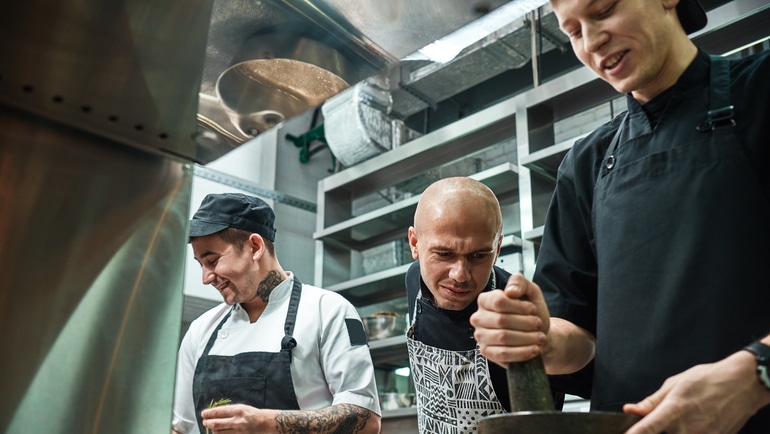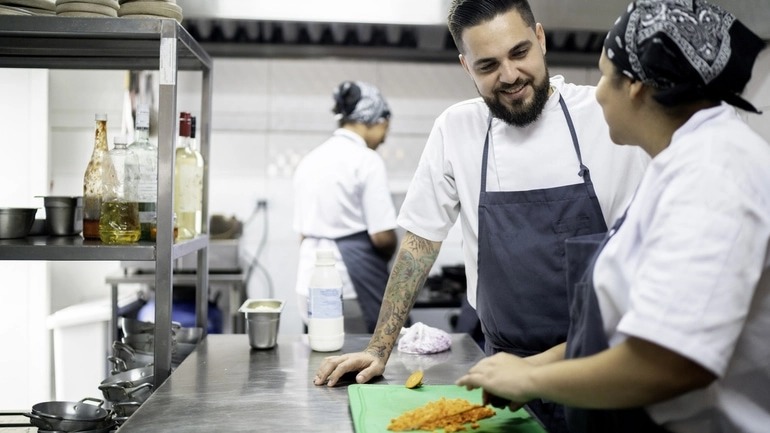Seasoned restaurateurs understand the importance of tracking their restaurant turnover rate.
That’s because the restaurant industry is notorious for high employee turnover. In fact, the restaurant staff turnover rate reached a high of 75% in 2019 – the highest of any industry. And for fast food restaurants, employee turnover runs as high as 130% to 150%.
Even if your own restaurant isn’t dealing with such astronomical turnover rates, the regular coming and going of staff can certainly take its toll on your business. Not only is it more expensive to hire new staff than to retain existing employees, but high turnover can also impact day-to-day workplace performance.
As one study by 7Shifts found, 47% of restaurants were negatively affected by employee turnover in 2019, and less than a third of operators said their turnover rate had no impact on their business. In other words, low restaurant turnover is essential to a successful business and a healthy workplace culture.
To help you get your turnover rate to where it needs to be, this guide will cover everything you need to know, including:
- What does restaurant turnover rate mean?
- Why it’s important to keep your employee turnover rate low
- How to calculate turnover rate for your restaurant
- 9 practical ways to decrease restaurant staff turnover
What Does Restaurant Turnover Rate Mean?
Before going any further, let’s clarify what the restaurant turnover rate means.
Turnover rate is a measurement of the frequency at which employees leave a job. For instance, if your restaurant had 20 employees and a turnover rate of 50%, that means that 10 employees left and needed to be replaced.
While the turnover rate varies by venue type, restaurants generally see a higher turnover rate than other industries. In part, this is because the restaurant industry is the U.S. economy’s largest employer of teenagers. And while many teens start off working in restaurants, most eventually go on to different careers outside the industry.
A high turnover rate can also be linked to the high proportion of students and seasonal staff working in the industry. Both students and seasonal workers don’t typically work a full-year schedule, which means turnover is generally high following the summer months. In fact, the restaurant industry is one of the largest creators of seasonal jobs, adding more than 500,000 jobs during an average summer season.
Even among full-year employees, turnover rates can still be high. In the restaurant industry, upward career mobility often happens when an employee moves from one restaurant to another. And with so many restaurants around, employees have ample opportunity to move from one venue to another.

Why Should You Keep Restaurant Turnover Low?
Of course, just because a high turnover rate is common in the restaurant industry, it doesn’t mean you should ignore it.
High restaurant turnover is problematic for your business for a number of reasons:
1. It’s Expensive
Perhaps the most obvious impact of a high restaurant turnover is the cost of hiring new employees. According to a study from the Center for Hospitality Research and Cornell University, the average cost of replacing just a single hospitality employee is $5,864. For an average full-service restaurant, that could add up to $146,000 annually – costs that can make or break for some your business.
2. It Negatively Impacts Team Workplace Culture
Cost aside, a high turnover rate can also have a negative effect on your workplace culture and staff performance. If it seems like you have a revolving door of employees, it can be hard for staff to bond with one another and develop strong working relationships. And with 76% of restaurant employees citing their co-workers as the best thing about their restaurant jobs, it’s clear that a staff that gets along is crucial to healthy workplace culture.
3. It Impacts The Customer Experience
Related to the issue of a poor workplace culture is the impact on the customer experience. When turnover is high, it means you may often be short on staff – specifically experienced staff who know your restaurant and customers well. This kind of shortage can slow down service, create bottlenecks, and increase the risk of mistakes – all of which can add up to a poor customer experience.
How to Calculate Turnover Rate for Your Restaurant
It’s clear that employee turnover is one of the most important restaurant metrics to track. So to find out how your restaurant is doing, you’ll need to know how to calculate restaurant employee turnover rate.
To calculate turnover rate, start by choosing a period of time to measure. It can be helpful to calculate your turnover rate on a monthly or quarterly basis to see how it changes throughout the year.
Next, divide the number of employees who have left your restaurant by the number of employees it takes to fully staff your restaurant. Then multiply the resulting number by 100 to get your restaurant turnover percentage.
(# of employees who have left your restaurant ÷ # of employees for a full staff) x 100
= staff turnover rate
To illustrate what this might look like, let’s calculate the annual restaurant turnover rate for a full-service restaurant. Let’s say Moe’s Diner is fully staffed at 24 employees, but 10 left over the course of the year. In this case, the restaurant turnover rate calculation for Moe’s Diner would look like this:
10 ÷ 24 = 0.42
0.42 x 100 = 42%
In this case, Moe’s Diner has an annual staff turnover rate of 42% – a figure that suggests room for improvement.
While this kind of manual calculation is relatively straightforward, you can easily automate this process by using labor management software that integrates with your restaurant POS system.

9 Ways to Decrease Restaurant Turnover
Now that you know how to calculate your restaurant turnover rate, you can figure out whether you need to make some changes to prevent employees from walking out the door.
Below, we cover how to reduce employee turnover in restaurants with 9 proven strategies.
1. Redefine your hiring strategy
One of the best ways to keep restaurant turnover low is by hiring the right people in the first place. Instead of basing your hiring decisions solely on experience (or even just availability), consider hiring based on values. Using a values-based hiring process can help you find and hire employees who are just as passionate about your vision as you are.
Before hiring your next employee, work on pinpointing your company values. It can help to identify some of your all-star staff and figure out what shared traits make them great at their jobs. For instance, you might find that one of your core values is putting the customer first or having a strong passion for your menu.
Once you’ve identified your core values, add these to your job descriptions to attract the right candidates – whether that’s a new line cook or a dining room manager. Then, in the interviews, ask questions that will help you identify whether or not the candidate shares your restaurant’s core values. This will help you weed out candidates that are unenthusiastic about your restaurant mission statement and company values.
2. Source internally
Instead of looking for new hires only when you’re desperate to fill a position, seek talent on an ongoing basis. And one of the fastest ways to find new employees is by creating an employee referral program for your business.
An employee referral program is a hiring strategy where your current team members refer people they know as potential hires for your team. Though some employees may provide you with referrals for free, these programs are generally most successful when your current employees have an incentive to bring in new talent. Consider offering rewards (such as cash, shift preferences, or vacation days) to current employees after a referred candidate has been hired and made it past their first 90 days.
While it may seem counterintuitive to pay your current staff to bring in new talent, this can actually help you save money and reduce restaurant turnover in the long run. As studies have shown, referred candidates are not only faster and cheaper to hire than traditional candidates, but they also tend to stay in their jobs longer.
3. Revamp your onboarding process
While hiring the right people certainly makes things easier, hiring is just half the restaurant turnover battle. Proper restaurant onboarding – the process of orienting new staff to your restaurant – is also necessary to make sure employees start off their job on the right foot.
When each new employee starts, ensure that they receive a full introduction to your rules, policies, guidelines, and processes. Whether you’re onboarding a new line cook or a server, you should walk each employee through your restaurant employee handbook. This can help to set expectations early and answer any major FAQs – all of which helps to avoid future misunderstandings that can lead to employee turnover.
And after you’ve been through the basics, be sure to arrange training for each new hire. This can include in-person instruction or assigning a veteran employee to mentor a new hire one-on-one.
Training can also include providing new employees with virtual resources. For instance, your POS provider likely has a library of free video tutorials and how-to training guides available that can help new staff members learn the basics. Additionally, organizations like ServSafe offer online programs to train employees in proper food handling, responsible alcohol service, and more.

Download your customizable template now to start your own handbook for your restaurant!
4. Check in with employees regularly
One of the best ways to uncover issues with your current operation is to monitor performance and check in with employees regularly to see how they are performing against restaurant benchmarks. Schedule both team meetings and one-on-one check-ins with your employees to give them an opportunity to provide feedback on how they’re performing and what you can do to support them. Simply by opening up a dialogue, you might uncover issues you didn’t even know your restaurant had and address problems before employees churn.

5. Improve your technology and training
Though you may be used to the technology in your restaurant, your employees may not be. According to a survey by 7Shifts, 28% of respondents said that poor workplace technology was their least favorite part of restaurant work.
In some cases, this might mean that you need to invest in your training process and making sure employees feel comfortable using all the technology in your restaurant. In other cases, it might require upgrading your current systems.
For instance, legacy POS systems are not very intuitive and can be difficult to learn to use – especially for younger employees used to cloud technology such as iPhones and iPads. This was the case for Café Crêpe, which switched from a legacy POS to TouchBistro’s user-friendly iPad POS system and saw an immediate reduction in its restaurant turnover rate.
“We found that our staff turnover dropped quite a bit in the first 30 days when we switched over to TouchBistro. We know the age of most of our staff is 17 to 25, so using TouchBistro was a lot more intuitive for them. It made service a lot easier for everyone, especially when you get those headaches of not being able to find a menu item… You can just type it in – like your phone.”
Lewis Hart, Café Crêpe, Vancouver and Hong Kong
6. Increase employee engagement
It’s no secret that disengaged employees feel less commitment to their employers. Therefore, if you want to reduce your employee turnover rate, engagement is a key part of the equation.
Though engagement will look different at every restaurant, you can experiment with the following strategies (some of which are totally free):
- Create opportunities for growth: Show your staff that there are opportunities for advancement within your restaurant and make that path to higher-level jobs clear and attainable. Then, nurture those who show interest in progressing in their career with ample education, extra training, and professional development opportunities.
- Offer meaningful perks and benefits: Offer staff competitive restaurant employee benefits that will convince them to stay at your restaurant instead of going somewhere else. This can include higher wages, but also health benefits, paid sick leave, vacation days, free meals, and more.
- Schedule well: 64% of restaurant staff say scheduling flexibility is one of the best parts of their job, meaning many value a positive work-life balance. Keep employees engaged and happy by offering flexible scheduling and accommodations when possible.
- Facilitate team bonding: Many restaurant employees cite their co-workers as one of the best parts of their job. Strengthen the bonds between your employees with regular team-building activities such as family meals or after-hours events.
7. Offer Higher Wages
A 7Shifts survey found that 42% of respondents cited low pay as the most disliked aspect of restaurant work, with many workers believing they do not receive fair compensation for the work they put in. Based on this sentiment, it’s no surprise that many workers switch jobs frequently in search of a higher salary.
Though it may seem counterintuitive, offering your staff higher wages (or even changing your tip out structure) can actually help you save money in the long run. If staff believe they are being fairly compensated for their work, they have less of an incentive to leave for another job. And when you retain your current employees, you save on the cost of hiring new ones.
8. Champion professional development
Higher wages are one way to keep employees happy, but it isn’t the only employee reetention strategy. Recognition is an important part of feeling like a valued member of the team, so you should be making an effort to recognize those doing good work.
And while not every employee wants to build a lifelong career in the restaurant industry, there are many that do. In fact, 7Shifts found that nearly 25% of restaurant workers want to get a promotion and move up in the industry. With that in mind, you should not just be recognizing great work, but also providing ongoing training and opportunities for advancement.
9. Conduct exit interviews after losing staff
Though you can test out lots of different ways to improve your employee retention strategy, you can gain the most insight by conducting exit interviews with those employees who leave voluntarily. Ask your employees for the honest reason why they want to leave and what would have made them stay. It may be something as simple as lack of training for a frustrating POS system, or something as big as poor management. This feedback can help you pinpoint exactly where changes need to be made so you can stop losing staff and reduce restaurant turnover.
Though you now know how to calculate turnover rate for your restaurant, the real work comes from keeping an eye on this valuable metric and making necessary changes. Over time, putting in the work to decrease your restaurant turnover rate can lead to happier staff, better served customers, and even more money in your pocket.
Download your free employee handbook template
Sign up for our free weekly TouchBistro Newsletter







